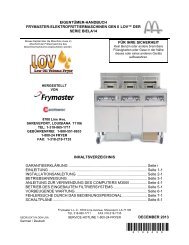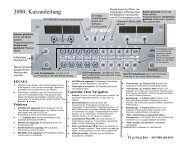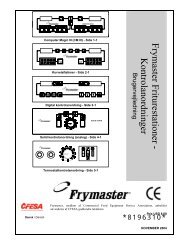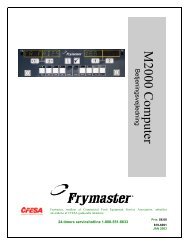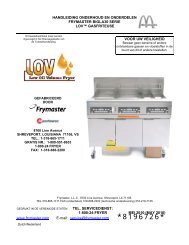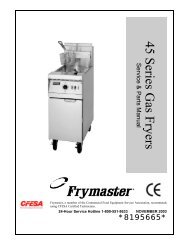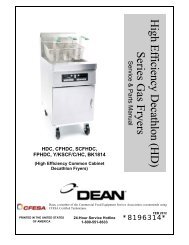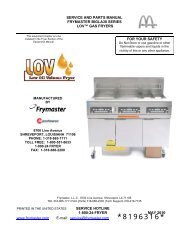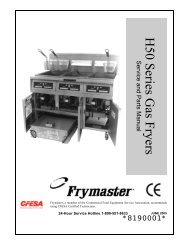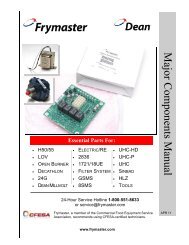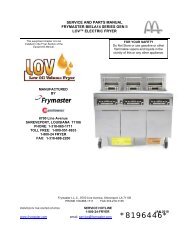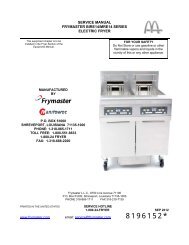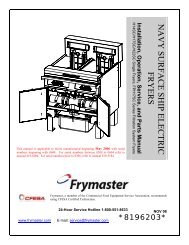Pro H50/55-Series Gas Fryers Service and Parts Manual - Frymaster
Pro H50/55-Series Gas Fryers Service and Parts Manual - Frymaster
Pro H50/55-Series Gas Fryers Service and Parts Manual - Frymaster
Create successful ePaper yourself
Turn your PDF publications into a flip-book with our unique Google optimized e-Paper software.
valve h<strong>and</strong>le appears to be in the closed position, the microswitch is still open). If the valve is fully<br />
closed, refer to the troubleshooting guide, TROUBLESHOOTING THE 24 VAC CIRCUIT.<br />
Some typical causes of ignition failure in this category include a defective sensing wire in the ignitor<br />
assembly, a defective module, a defective ignition wire, <strong>and</strong> a defective ignitor.<br />
Occasionally you may encounter an ignition failure situation in which all components appear to be<br />
serviceable <strong>and</strong> the microamp reading is within specification, but the unit nevertheless goes into<br />
ignition failure during operation. The probable cause in this case is an intermittent failure of an<br />
ignition module. When the unit is opened up for troubleshooting, the module cools down enough to<br />
operate correctly; however, when the unit is again closed up <strong>and</strong> placed back into service the module<br />
heats up <strong>and</strong> fails.<br />
PROBLEMS RELATED TO THE GAS VALVE<br />
If the problem is not in the 24 VAC circuit, it is most likely in the gas valve. Before replacing the<br />
gas valve, refer to TROUBLESHOOTING THE GAS VALVE.<br />
1.7.2 Improper Burner Function<br />
With problems in this category, the burner ignites but exhibits abnormal characteristics such as<br />
“popping,” dark spots on the burner ceramics, fluctuating flame intensity, <strong>and</strong> flames shooting out of<br />
the flue.<br />
“Popping” indicates delayed ignition. In this condition, the main gas valve is opening but the burner<br />
is not immediately lighting. When ignition does take place, the excess gas “explodes” into flame,<br />
rather than smoothly igniting.<br />
The primary causes of popping are:<br />
• Incorrect or fluctuating gas pressure<br />
• Defective or incorrectly adjusted combustion air blower<br />
• Inadequate make-up air<br />
• Heat-damaged controller or ignition module<br />
• Cracked ignitor or broken ignition wire<br />
• Defective ignition module<br />
• Cracked burner tile (typically causes a very loud pop).<br />
If popping occurs only during peak operating hours, the problem may be incorrect or fluctuating gas<br />
pressure. Verify that the incoming gas pressure (pressure to the gas valve) is in accordance with the<br />
appropriate CE or non-CE St<strong>and</strong>ard found in Section 2.3 of the <strong>Pro</strong> H<strong>55</strong>-<strong>Series</strong> <strong>Gas</strong> Fryer<br />
Installation <strong>and</strong> Operation <strong>Manual</strong> (part number 819-5991), <strong>and</strong> that the pressure remains constant<br />
throughout all hours of usage. Refer to Section 1.4, Checking the Burner Manifold <strong>Gas</strong> Pressure<br />
in this manual for the procedure for checking the pressure of gas supplied to the burner.<br />
If popping is consistent during all hours of operation, the most likely cause is an insufficient air<br />
supply. Check for “negative pressure” conditions in the kitchen area. If air is flowing into the<br />
kitchen area, this indicates that more air is being exhausted than is being replenished <strong>and</strong> the burners<br />
may be starved for air.<br />
1-24



